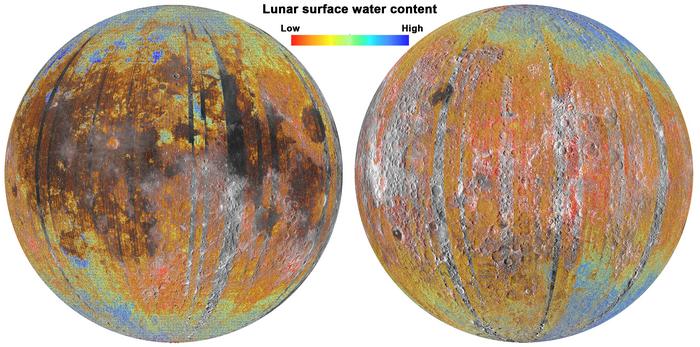
High-Energy Electrons in Earth’s Magnetic Tail Create Water on Moon
- Science
- September 16, 2023
Future crewed moon missions may be able to use the information to better understand where water is located on the lunar surface.
The moon is being weathered by high-energy electrons in a tail of plasma that surrounds the Earth, and even more intriguingly, it appears that water has started to form on the lunar surface.
The new results, which were made by a group of researchers led by Shuai Li, a researcher at the University of Hawaii at Manoa School of Ocean and Earth Science and Technology, may also explain how water collects in areas of the moon known as perpetually shadowed regions (PSRs), which are pockets that are never exposed to sunlight.
In addition to being crucial for comprehending how Earth’s natural satellite has evolved, knowledge of the distribution and concentration of water over the moon is also crucial for long-term crewed mission planning. The water they collected may be utilised by those space explorers for more than just food; it could also be used to produce fuel for staging missions from the lunar surface. These missions might use the moon as a launching pad for further solar system exploration, such as on Mars.
According to Li and colleagues, the magnetosphere, the magnetic bubble that surrounds the Earth, and water on the moon are related. Our planet is protected from high-energy charged particles by the magnetosphere, which is carried by the solar wind.
On the side of the Earth that faces away from the sun, often known as the planet’s nightside, a long magnetic tail is produced as a result of the solar wind slamming into the magnetosphere and deforming this magnetic shield. The magnetotail is a fitting name for this tail. Within the magnetotail, a plasma sheet is created by solar wind high-energy electrons and ions as well as particles from Earth.
The moon thus passes through the magnetotail as it orbits the Earth. As a result, the magnetotail protects the moon from charged particles while yet enabling light to reach the lunar surface, just like the magnetosphere does for the Earth.
“This provides a natural laboratory for studying the formation processes of lunar surface water,” Li said in a statement. “When the moon is outside of the magnetotail, the lunar surface is bombarded with solar wind. Inside the magnetotail, there are almost no solar wind protons, and water formation was expected to drop to nearly zero.”
He and his team evaluated how water production changes when the moon passes through the magnetotail using data gathered between 2008 and 2009 by the Moon Mineralogy Mapper (MMM) instrument onboard the Chandrayaan 1 satellite.
“To my surprise, the remote sensing observations showed that the water formation in Earth’s magnetotail is almost identical to the time when the moon was outside of the Earth’s magnetotail,” Li explained. “This indicates that, in the magnetotail, there may be additional formation processes or new sources of water not directly associated with the implantation of solar wind protons.”
Li discovered, in particular, that the effects of radiation produced by high-energy electrons in the magnetotail are comparable to those of radiation produced by ions in the solar wind.
Li had initially considered weathering processes on the lunar surface that take place while the moon travels through the magnetic tail of Earth in order to begin thinking about the connection between the magnetotail and the moon. This demonstrated that iron in the polar regions of the moon rusts due to oxygen in the magnetotail.
“Altogether, this finding and my previous findings of rusty lunar poles indicate that Mother Earth is strongly tied with its Moon in many unrecognized aspects,” Li added.
By examining the plasma environment around the moon and the water content at the lunar poles at various times during the moon’s passage through the magnetotail, the team hopes to build on this result.
This study will be done as a part of the Artemis programme, which will launch the Artemis III mission to the moon as early as 2026. The goal of the mission is to send the first woman and person of colour to the moon’s surface and bring back humans to the moon for the first time in 50 years.